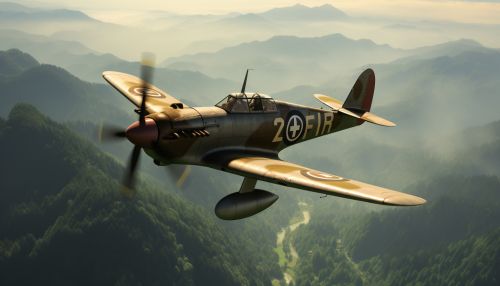Messerschmitt Bf 109
Development
The Messerschmitt Bf 109 was a German World War II fighter aircraft designed by Willy Messerschmitt and Robert Lusser during the early to mid-1930s. The "Bf 109" designation was issued by the German ministry of aviation and represents the developing company Bayerische Flugzeugwerke (at which the engineer Messerschmitt led the development of the plane) and a rather arbitrary figure.


The Bf 109 was one of the first truly modern fighters of the era, including features such as a fully enclosed cockpit, retractable landing gear, and a liquid-cooled, inverted-V12 aero engine. The Bf 109 was produced in greater quantities than any other fighter aircraft in history, with a total of 33,984 units produced from 1936 to April 1945.
Design
The Bf 109 was designed by Bavarian Aircraft Works, and its chief designer, Willy Messerschmitt, intended the Bf 109 to be a versatile aircraft, capable of performing various tasks. The design was to be as simple as possible to facilitate production and eliminate potential problems on the assembly line.
The aircraft was powered by a Daimler-Benz DB 601 inline engine, which gave the aircraft its streamlined shape. The engine was a liquid-cooled, inverted V12, which allowed for a more streamlined nose and provided the pilot with better visibility.
The Bf 109 used a monocoque construction, with a single structural shell for the aircraft's body. This design made the aircraft lighter and allowed it to carry a heavier payload. The wings were of a low-wing cantilever design and were made of an aluminium frame, covered with duralumin and fabric.
Operational History
The Bf 109 first saw operational service during the Spanish Civil War and was still in service at the dawn of the jet age at the end of World War II, during which time it was the backbone of the Luftwaffe's fighter force. From the end of 1941, the Bf 109 was supplemented by the Focke-Wulf Fw 190.
The Bf 109 was used by the Luftwaffe and several other countries during World War II, and beyond. It was the mainstay of the Luftwaffe's fighter force, and was used in all theatres of war where the Luftwaffe operated.
Variants
There were many variants of the Bf 109, which were designed to perform a variety of roles. These included fighter-bomber, day-, night-, all-weather fighter, ground-attack aircraft, and as reconnaissance aircraft. The Bf 109 was supplied to several states during World War II, and served with several countries for many years after the war.
Legacy
The Bf 109's design and development had a profound effect on the design of fighters and other types of aircraft. Its legacy can be seen in many of the jet fighters of the 1950s and 1960s, and it remains one of the most well-known and iconic aircraft of World War II.
